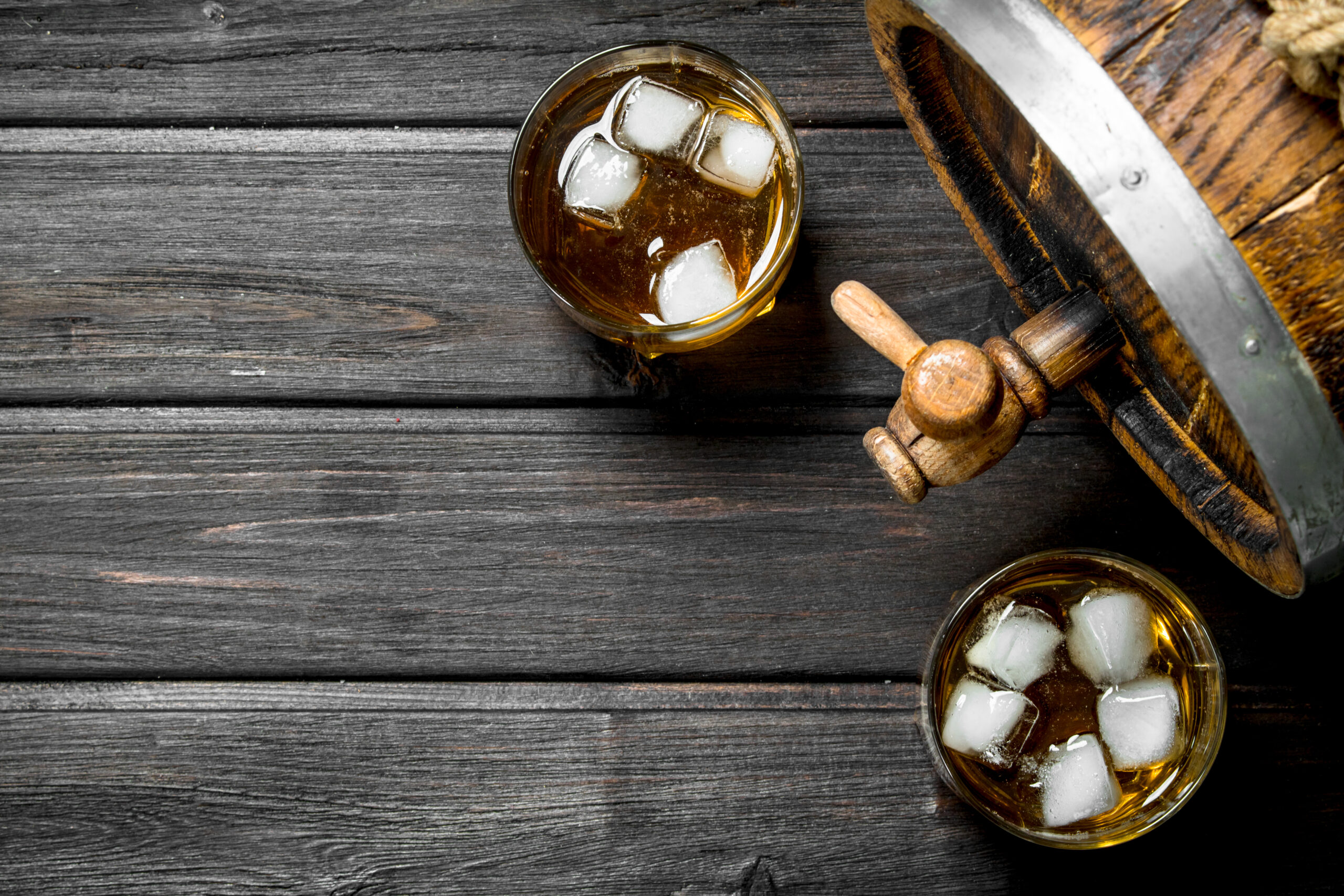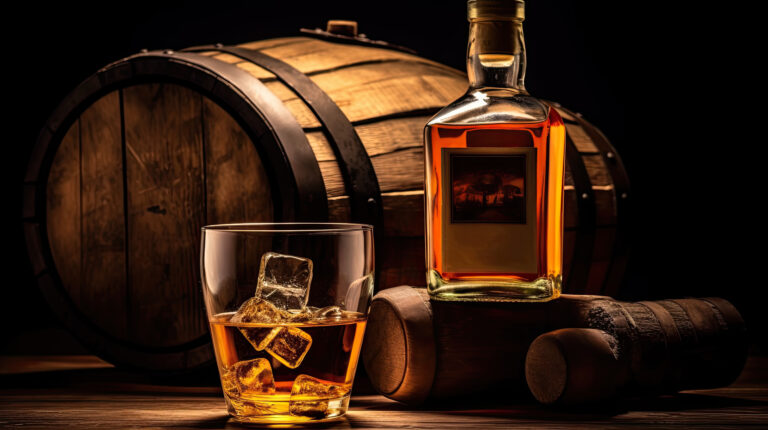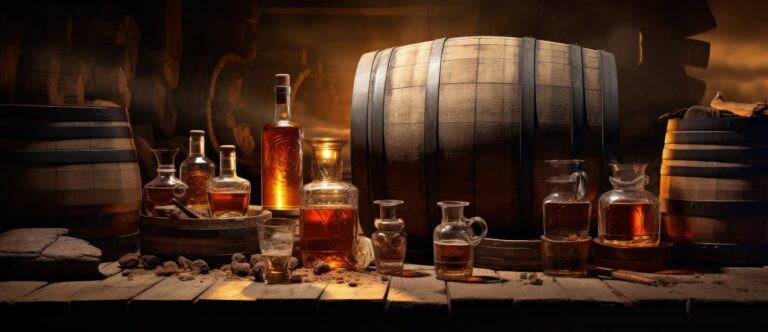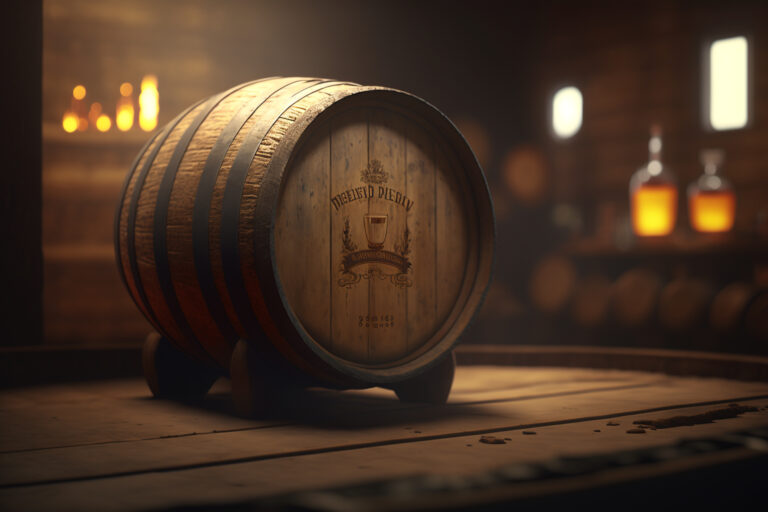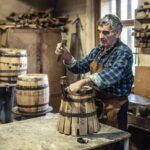Ever wondered why some whiskeys seem to mature faster than others? The barrel size used during aging is a huge factor! As a whiskey enthusiast, you probably know that maturing whiskey in smaller barrels means more surface area is exposed to the wood. This supercharges the interaction between the whiskey and the barrel, speeding up the maturation process. The smaller the barrel, the quicker this magic happens. While a full-size 53-gallon barrel might take 6-8 years for the whiskey to reach its prime, a tiny 5-10 gallon barrel can achieve the same effect in just 6-18 months. So next time you’re Browse the whiskey aisle, ponder how barrel size contributes to the flavor and aroma notes of your favorite drams. That age statement on the bottle might not tell the whole story!
Introduction: The Effect of Barrel Size on Whiskey Maturation
The barrel size used to age whiskey has a direct impact on how quickly it matures. Think of it this way: smaller barrels mean more surface area is exposed to the whiskey, allowing for a faster extraction of those delicious flavors from the wood.
Barrel Size and Surface Area
A standard whiskey barrel typically holds about 53 gallons, while those smaller barrels can range from 5 to 30 gallons. The smaller the barrel, the greater its surface area to volume ratio. More surface area means the whiskey has more direct contact with the oak, soaking up characteristics like vanilla, caramel, and oak flavors at a much quicker pace.
Faster Maturation in Small Barrels
In a smaller barrel, the whiskey actually penetrates deeper into the wood, pulling out more flavor compounds. That smaller volume also allows for quicker temperature changes, which really gets those chemical reactions between the whiskey and wood humming along. The result? A rapidly maturing spirit in a matter of months, not years!
However, some folks argue that small barrels can sometimes impart an overly “woody” flavor that just doesn’t have the complexity of a slower-aged spirit. That’s why many master distillers cleverly use a combination of barrel sizes to strike that perfect balance between maturation speed and depth of flavor.
Other Factors That Influence Maturation
While barrel size is certainly key, other elements like the barrel char level, the wood type (think American oak versus French oak), and even the environmental conditions in the rickhouse all play a role in how fast a whiskey matures. The interplay between all these factors ultimately determines the unique flavor profile of a whiskey. Understanding the effect of barrel size is just one piece of the fascinating puzzle that is spirit maturation.
Ultimately, barrel size often boils down to a distiller’s stylistic choice. Whether small or large, a barrel’s most important job remains the same: housing a spirit on its magical journey into becoming a truly remarkable whiskey.
Small Barrels Allow More Contact With Wood
Smaller barrels mean there’s significantly more surface area for the whiskey to cozy up to the wood. In a typical 53-gallon barrel, the whiskey is exposed to roughly 50 square feet of wood. Now, compare that to a 5-gallon barrel with over 10 square feet of surface area – that’s a whole lot more wood contact for the volume of whiskey!
More wood contact translates to faster maturation. The whiskey can absorb barrel flavors like vanilla, caramel, and oak much quicker. It also lets more oxygen interact with the whiskey, speeding up oxidation and mellowing the spirit in a hurry.
You’ll actually notice the whiskey in a small barrel darken in just a few months as it rapidly pulls compounds from the charred wood. The whiskey will develop a rich, robust flavor in a short period of time. Tasting notes often describe small-barrel whiskies as having intense wood and spice flavors.
While larger barrels typically need 3-5 years for full maturation, a quality whiskey can be ready in just 6-18 months when aged in smaller casks. This accelerated interaction with the wood means you get an intensely flavored, complex whiskey in a fraction of the time.
Of course, there’s a trade-off. Whiskeys aged in smaller barrels tend to lose more volume to evaporation (the “angel’s share”) compared to larger barrels. They also sometimes lack some of the subtlety and balance that comes with longer aging. But for many, the benefit of a quick batch of intensely flavored whiskey outweighs these factors.
In the end, barrel size comes down to your priorities and patience as a distiller. Small barrels offer a chance to get innovative and push flavor boundaries in a short amount of time. Larger barrels reward patience but also provide the opportunity to craft a truly well-rounded, timeless whiskey. Whatever you choose, barrel size has a huge impact on maturation and is a key tool for creating distinctive whiskeys.
Less Liquid Means Faster Oxidation
A smaller barrel means there’s less liquid inside, so the whiskey has more surface area exposed to oxygen. This increased exposure to oxygen means the chemical reactions that create the incredible flavors and aromas of aged whiskey happen faster. This process is often referred to as oxidation.
Greater Surface Area
In a smaller barrel, the whiskey has a greater surface area relative to its volume. This creates more opportunities for the whiskey to truly interact with the barrel wood. The wood can impart more of its desirable characteristics, like those lovely vanilla, caramel, and oak flavors, in a much shorter period of time.
Faster Diffusion
With less liquid in the barrel, it’s easier for compounds to diffuse, or spread out. This allows the volatile compounds that create aroma and flavor to move freely between the barrel and the whiskey. Diffusion happens more rapidly, enabling the whiskey to take on the barrel’s characteristics with impressive speed.
Quicker Temperature Changes
A smaller amount of liquid is simply more responsive to changes in temperature. As temperatures rise and fall in the warehouse, the whiskey’s temperature changes swiftly. These temperature fluctuations cause the barrel wood to expand and contract, essentially pushing the whiskey in and out of the wood. This constant movement exposes the whiskey to more of the barrel, significantly accelerating maturation.
Increased Evaporation
When there’s less whiskey in the barrel, a greater proportion of it evaporates. This is famously known as the “angel’s share.” While evaporation does reduce the total amount of whiskey, it also concentrates the remaining flavors and compounds. The end result is a whiskey with an intense, complex flavor that tastes older than its actual age.
So, while a larger barrel will generally produce a milder, smoother spirit over time, a smaller barrel creates an accelerated aging effect. For those who prize robust, distinctive flavors, a whiskey aged in a petite barrel can be a real treat. The trade-off is a lower overall yield, but for many distillers and consumers, the flavor is absolutely worth it.
Temperature Fluctuations Are More Extreme in Small Barrels
The barrel size used for aging whiskey has a profound impact on how quickly it matures. Smaller barrels, like those commonly used for bourbon (typically 53 gallons), allow for more intimate interaction between the whiskey and the wood. This means the whiskey absorbs flavors and colors from the charred oak at a faster clip.
Temperature changes also have a much bigger effect in small barrels. As the temperature rises and falls, the whiskey expands and contracts. This causes it to be pushed deep into the wood, then drawn back out again. Over time, this repetitive motion results in more oak compounds being dissolved into the whiskey. The greater surface area to volume ratio of small barrels also means there’s more oak exposed to the whiskey, speeding up the infusion of flavors.
Extremes in Temperature
Small barrels experience wider temperature variations than large barrels during the aging process. The smaller volume of whiskey is simply more impacted by changes in environmental temperature. This causes greater fluctuations between the barrel headspace and the liquid inside. When the temperature rises, the pressure builds and the whiskey is forced into the wood. When it falls again, the whiskey draws flavor compounds back out of the wood. This expansion and contraction cycle significantly accelerates maturation.
In contrast, the larger volume of whiskey in big barrels (often over 500 gallons for scotch and brandy) is less reactive to environmental temperature changes. The liquid inside doesn’t fluctuate in temperature as dramatically. This means the whiskey interacts with the wood more gradually, resulting in a slower maturation.
While small barrel aging produces whiskey more quickly, many argue that large barrels create a smoother, mellower spirit. The slower maturation allows complex flavors to develop gradually. However, for those eager to sample the fruits of their labor, small barrels do offer a chance to enjoy well-matured whiskey in less time.
More Angel’s Share Evaporation in Small Barrels
The barrel size used for maturation has a significant impact on how quickly whiskey develops. Smaller barrels, like those often used for bourbon (typically 55 gallons), boast a higher surface area to volume ratio. This means more of the whiskey is in direct contact with the charred oak, allowing for faster extraction of flavors and aromas.
More Surface Area
In a smaller barrel, a greater proportion of the whiskey is in direct contact with the charred oak staves. This close proximity to the wood means compounds like vanillin, oak lactones, and tannins can be absorbed faster, accelerating maturation. The higher surface area to volume ratio is like increasing the potency of the oak by concentrating its effects on the spirit.
Faster Temperature Changes
The smaller the barrel, the faster the whiskey responds to changes in temperature. As the weather warms in the summer, the whiskey’s temperature increases more quickly in a small barrel. Higher heat causes the wood to expand, enabling compounds to migrate into the whiskey more rapidly. The inverse happens in winter as temperatures drop. These dramatic seasonal shifts really speed up the maturation process.
Increased Evaporation
More surface area also means increased evaporation of the whiskey, famously known as the “angel’s share.” Up to 10% of the barrel’s contents can be lost to evaporation each year. While this might seem counterintuitive, evaporation actually concentrates the remaining whiskey by removing water and intensifying flavors. The additional loss in small barrels produces a whiskey with more robust oak and spice notes in a shorter period of time.
Maturation Accelerated
All told, maturation in a small barrel can take just 3 to 5 years for a whiskey to develop a full range of oak, caramel, and vanilla flavors that might require 12 years or more in a standard-size barrel. For those lacking patience, using small barrels is a smart way to enjoy aged whiskey without the long wait. Of course, some purists believe only time can truly produce a complex, well-rounded spirit, but small barrels can get you most of the way there in a fraction of the time.
Small Barrels Can Over-Oak Whiskey
Small barrels, typically 53 gallons or less, are quite popular these days for aging whiskey. Barrel size significantly impacts how quickly the whiskey matures and develops flavor. However, a word of caution: small barrels can over-oak the whiskey if you’re not careful.
When you age whiskey in a smaller barrel, the increased surface area to volume ratio means the spirit has more contact with the wood. This accelerates the maturation process, allowing flavors to develop faster. The trade-off is that small barrels also impart oak flavors more quickly, which can overwhelm the whiskey’s natural flavors if left for too long.
To steer clear of over-oaking in small barrels, you need to keep a close eye on the whiskey during maturation and bottle it at just the right moment. As a general rule of thumb, aim for shorter maturation periods in small barrels – think 6-24 months instead of years. Taste the whiskey regularly after the first few months to figure out when the oak flavors are balanced and the whiskey has reached its desired maturity.
- Check for inviting notes of vanilla, caramel, and spice, which are good indicators that the oak is influencing the flavor nicely.
- Once the whiskey starts to taste overly woody or bitter, it’s definitely time to bottle.
- Don’t rely solely on color to determine maturity in small barrels. Taste is truly the best indicator.
The type of oak used and the level of char or toast on the barrel also impacts how quickly it will impart oak flavors. Barrels made of American oak tend to be more porous than French oak, so they often accelerate maturation. Heavily charred barrels also speed up the interaction between the spirit and wood. For small barrels, opting for a lighter toast or medium char can be a smart move.
While small barrels demand diligent management, when used properly, they can produce a nicely-matured whiskey in a fraction of the time of larger barrels. Pay close attention, bottle at the perfect moment, and you’ll be enjoying your well-crafted whiskey before you know it!
Large Barrels Allow Longer, Slower Maturation
Large barrels are the secret to slower, longer maturation of whiskey. The greater volume of whiskey in bigger barrels means less surface area exposed to oxygen. This naturally reduces interaction with the wood, slowing down flavor and color development.
Less Evaporation
In smaller barrels, a greater portion of the whiskey comes into contact with the wood, leading to more evaporation of the “angel’s share,” which reduces volume and concentrates flavors. Bigger barrels have less surface area relative to volume, so less whiskey escapes as vapor. Your whiskey has more time to age and develop character without diminishing in quantity.
Gradual Flavor Infusion
The whiskey absorbs flavors and aromas from the wood slowly, steadily, over time. Large barrels give the liquor ample opportunity to mellow and soften as subtle oak and vanilla notes gently infuse into the spirit. The result is a smooth, complex bouquet. In stark contrast, small barrels speed up this process, often leading to a harsh, overly woody character.
Patience Rewarded
Whiskey maturation truly demands patience. Big barrels enable an unrushed aging process, allowing nature to take its course. As seasons change, the whiskey expands and contracts, soaking into the wood, then retreating again. Over years and decades, this cycle repeats, creating an incomparable, multi-layered flavor that simply cannot be rushed. Superior whiskeys are absolutely worth the wait.
While small barrels certainly have their place for certain styles, when it comes to premium whiskeys meant for sipping, size matters. For the most refined, balanced drams, large barrels just can’t be beat. Bigger really is better, allowing for the slowest, gentlest aging and greatest depth of flavor. If you want a whiskey to truly stand the test of time, give it time in a big barrel. Your patience will be richly rewarded.
Finding the Optimal Barrel Size for Your Goals
The barrel size used to age whiskey has a significant impact on how quickly it matures. It’s a simple equation: the smaller the barrel, the faster the whiskey ages. This is because there’s more surface area in a small barrel relative to its volume, allowing for increased interaction between the whiskey and the wood, which accelerates the aging process.
Standard Whiskey Barrels
The most common barrel size for aging whiskey is the standard barrel, which holds approximately 53 gallons or 200 liters. At this size, whiskey typically ages around 4 to 6 years before being bottled. For smaller craft distilleries, using standard barrels allows them to release aged products without waiting too long.
Small Barrels
Barrels that hold 5 to 30 gallons, often called small barrels or quarter casks, speed up maturation to just 6 months to 2 years. The increased wood contact and oxidation creates whiskey with intense wood and spice notes in a short time. However, small barrels also mean more alcohol is lost to evaporation (the angel’s share), and the whiskey can become over-oaked if aged too long. Small barrels are a good option if you want to release an aged product quickly while experimenting with different barrel types like oak, hickory, or maple.
Large Barrels
Barrels larger than the standard size, holding 100 gallons up to 600 gallons (like a hogshead or butt), slow down the aging process. Whiskey may age for 10-30 years or even more before being bottled. While large barrels mean less alcohol is lost to evaporation, the whiskey ages more gradually. The result is a smoother, mellower flavor than smaller barrels. However, the longer aging period requires significant patience and capital. Only a few distilleries use very large barrels.
In the end, the barrel size you choose really depends on how quickly you want to release an aged product and the flavor profile you’re aiming to achieve. Smaller barrels mean intensified flavors in less time, while larger barrels result in a slower maturation and mellower taste. Finding the right balance for your goals is absolutely key to crafting exceptional whiskey.
The Effect of Barrel Size on Whiskey Maturation Rate FAQ
The barrel size used to age whiskey has a significant impact on how quickly it matures. You might think bigger barrels would speed things up, but it’s actually the opposite!
Smaller Barrels Mean Faster Aging
Actually, smaller barrels – like those used for bourbon (typically 53 gallons) or even some quarter casks – have a higher surface area to volume ratio. This means more of the whiskey is in direct contact with the wood, leading to faster maturation and more pronounced wood flavors. Conversely, very large barrels used for some single malt scotches (like ex-bourbon or ex-sherry casks of various sizes) have less surface area relative to their volume, so less contact with wood. This actually slows down maturation and results in subtler wood flavors. So, the smaller the barrel, generally the faster the aging process.
Surface Area to Volume Ratio
The surface area to volume ratio of a barrel is crucial; it determines how much of the whiskey is in contact with the wood at any given time. The smaller the barrel, the higher this ratio, and the faster desirable compounds from the wood are imparted to the spirit.
More Oxidation
In addition to wood contact, oxidation also plays a vital role in maturation. Smaller barrels allow for more oxidation because of the increased headspace to spirit volume ratio. This additional oxidation further accelerates the aging process.
Additional Factors
While barrel size is super influential, other factors like barrel char level, barrel type (new oak vs. used casks), barrel toast level, warehouse conditions (temperature, humidity), and even the entry proof of the new make spirit can also affect maturation speed and flavor. But as a general rule, smaller barrels mean faster aging and bolder wood flavors in the final product.
So, while barrel size isn’t the only factor in how quickly your favorite whiskey matures, it certainly has a significant influence. If you prefer bold, robust wood flavors, you’ll probably enjoy whiskeys aged in smaller barrels. If you like subtler, more nuanced wood influence, larger barrels used for aging may be more to your taste.
Final Thoughts
So, at the end of the day, while barrel size definitely has an effect on how quickly whiskey matures, it’s really just one piece of a much larger, fascinating puzzle. As with so many things in life, patience is truly key when it comes to whiskey. If you want to experience the complex, multi-layered flavors that only time can build, you’ve got to give the whiskey ample opportunity to soak it all in. Sure, a smaller barrel might get you to a certain point a bit faster. But let’s be honest, there are no real shortcuts to crafting a truly memorable, finely-aged spirit. Great whiskey is meant to be savored slowly, not rushed. So, when it comes to your next pour, remember that barrel size matters, but perhaps less than taking the time to appreciate all the subtle notes that a patient maturation process can unlock. Sip, enjoy, and happy exploring the wonderful world of whiskey!
